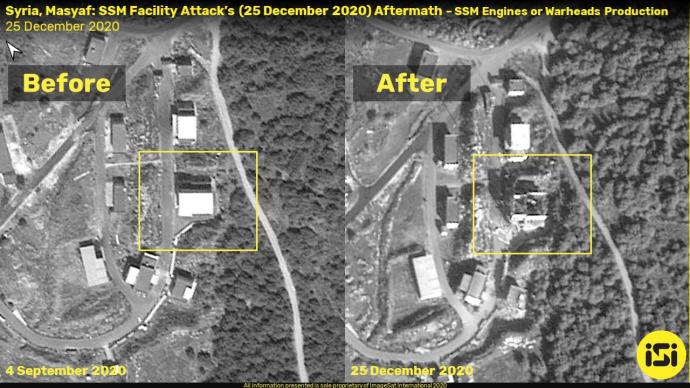Images published by Israeli intelligence firm ImageSat International (ISI) of a site allegedly struck by Israel on Friday show its complete destruction.
According to ISI, the structures that were hit served as an entrance to underground tunnels and were completely destroyed by the airstrikes. The same structures were hit on September 2018 in another strike blamed on Israel and were rebuilt.
The Britain-based Syrian Observatory for Human Rights, which monitors the Syrian civil war, said that at least eight missiles were fired toward weapons depots and sites belonging to Iranian militias.
A five-man crew of a Pantsir missile-defense system was killed after firing toward Israel Air Force jets. Another seven civilians were injured.
According to SOHR, it was the 12th Israeli attack on Syrian territory since the beginning of the year. The report by ISI said that the strikes came after the IAF struck Syria’s Scientific Studies and Research Center (SSRC) east, north and west on April 9.
“ISI assesses that this underground facility is related to the SSRC facility in Masyaf,” the report said.There have been numerous airstrikes in the Masyaf area, which is thought to be used by Iran as a base for their militia forces. The area is also where the SSRC - known also by its French name Centre D’Etudes et de Recherches Scientifiques - is located.
Israeli officials have repeatedly voiced concerns over Iran’s entrenchment in Syria and the smuggling of sophisticated weaponry to Hezbollah from Tehran to Lebanon via Syria, stressing that both are red lines for the Jewish state.
Israel has been carrying out its war-between-wars campaign for close to a decade in an attempt to prevent Iran from entrenching itself in Syria and to stop Tehran from smuggling advanced weaponry.
The Iranian Revolutionary Guard Corps and its Quds Force were the main targets of Israel’s war-between-wars campaign, known in Hebrew as MABAM. Over the years it has carried out thousands of kinetic strikes, in Syria and further from its borders, by land, sea and air, as well as by cybernetic means in order to prevent the Iranian regime from reaching its goals of regional hegemony and becoming a nuclear state.
Israel has repeatedly increased its strikes in Syria despite an increase in tension with Russia, which is enormously influential after Moscow intervened in 2015 on the side of President Bashar Assad.
Israel and Russia have a safety mechanism in place in order to make sure that Moscow is informed ahead of Israeli action.
In July 2019, ISI released satellite imagery that showed the complete deployment of four Russian-made S-300 missile-defense systems in Masyaf.
Russia delivered the launcher, radar and command-and-control vehicle of the advanced air-to-surface missile system to the Assad regime after a Russian reconnaissance plane was downed by Syrian air defenses during an Israeli airstrike on Iranian targets.
The Syrian Arab Army is equipped with a range of older Russian-made surface-to-air missile systems such as the SA-2, SA-3, SA-5, SA-6,-SA-8, SA-11, SA-17, SA-19, SA-22, and Pantsir s1 air defense systems.
Russia has also deployed their advanced S-300 and S-400 air defense batteries but has not given them to the Syrians, rather they man themselves. They have yet to be used against Israeli jets, in part due to the ongoing safety mechanisms in place between Jerusalem and Moscow.
While the response time by Syrian SAMs to Israeli operations has become quicker and they have fired over 1,000 missiles toward Israeli jets in the past seven years, they have been unable to stop them from carrying out their missions.

